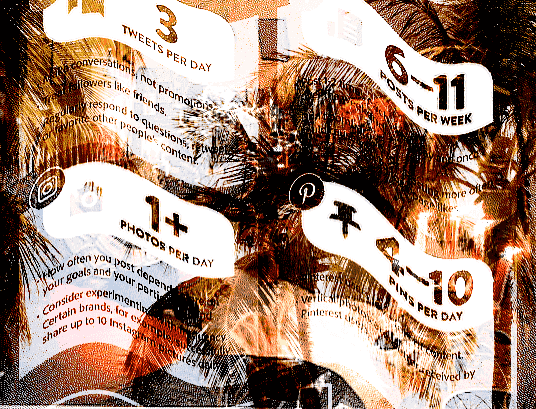

Blogging Less in the 2020s
How frequently should you post to keep pace with the next decade?
Posting every day — multiple times a day — is indispensable. This is one of the main factors the Instagram algorithm uses to determine how much they are going to expose you to the public (via the “explore page”). Posting every day, especially at “rush hour” times, is much harder and more monotonous than you might think. Most people give up on this task after a few weeks, and even missing a day or two can be detrimental. So, I automated the content collecting and sharing process.
— Chris Buetti, “How I Eat For Free in NYC Using Python, Automation, Artificial Intelligence, and Instagram”
Facebook posts reach their half-life at the 90-minute mark, nearly four times longer than Twitter.
— Buffer’s “Social Media Frequency Guide”
Consistency. Asking friends who work in social media and marketing, this is the current dominant advice - for both ‘influencer’ types and DIY creators. This word seems to be everything right now.
The implication is that you should post frequently, with as much quality as you can muster, to stay relevant. Otherwise, you’ll drop off the end as new ‘content’ crowds it out. And this is happening all day.
The fact that they only post twice a week sheds light on their poor performance. While Nike is a cool brand, their social media content’s infrequencies are taking a toll.
— Dash Hudson, “The Truth About How Often You Should Be Posting on Instagram”
This is an artifact of how social media platforms are constructed. It doesn’t benefit the writer to need to focus on consistency over quality, does it? So does it benefit the reader?
It benefits the platform. And, at this point, there are many different platforms, all demanding your ‘consistency’.
Post to Twitter at least 5 times a day. If you can swing up to 20 posts, you might be even better off.
Post to Facebook five to 10 times per week.
Post to LinkedIn once per day. (20 times per month)
— Buffer’s “Social Media Frequency Guide”
So, minimum 47 posts per week on these three networks. Recommended: 157.
Last year I decided to begin posting only on Tuesday Friday. (Since changed to Monday and Thursday.) I might post a couple times on each of those days. Even worse: I’m posting on a blog in the middle of nowhere, not on a platform that has the benefit of an existing network of users. (Unless you consider the Web itself an existing network of users.)
Convention dictates that I should now show a bunch of statistics demonstrating that posting biweekly had a great statistical benefit and led to ‘success’. However, I believe that would be a cold comfort.[1] I don’t keep traffic statistics - my favorite novels don’t have tracking devices inside, do they? And articles that statistically show ‘success’ are what have led us to ‘consistency’. I don’t think my social media friends are wrong about what is working in 2019.
Most weblogs are unfunded, spare-time ventures, yet most webloggers update their sites five days a week, and some even work on weekends!
— p. 127, Rebecca Blood, The Weblog Handbook (2002)
Does anyone really want ‘likes’? Or do they want ‘followers’? Or ‘visits’ or ‘impressions’? These are numerical decoys for something else.
When I think about writing online - I really just want to add something to someone’s life. To introduce them to a link, in the same way that Andy Baio introduced me to HIGH END CUSTOMIZABLE SAUNA EXPERIENCE. Or to write something they enjoy, just as Nadia Eghbal did with “The Tyranny of Ideas” - an essay I keep coming back to. Or maybe I meet them and can’t even sum it up with a single link, as with h0p3 (at philosopher.life) who I just like to converse with and keep up with throughout my week.
In this way, I feel successful. I might get a nice e-mail from someone. Or I might hear from someone I linked to, saying, “Hey, I had a few people find me through you.” Or I might just not know at all - most people just read and move on, which is totally understandable. And it might be several years later that they say thanks in some blog post that I stumble across.
I think that, even if you do play the ‘consistency’ game, you have to come to terms with not knowing. Why not start there then?
There are lots of strategies out there for gaming the system: posting at optimal times on a regular schedule, using hashtags and keywords, etc, but algorithms change and update as quickly as users adapt, and a battle where you can only react to your opponents moves isn’t one that can be won.
— Y. Kiri Yu, “The Only Way to Beat Algorithms is to Retrain Your Audience”
If I could statistically show you the good memories - the ones I will hold on to - from the past two years, I would show that graph here. I think that would be a useful statistic!
I can list some advantages to working on the Monday Thursday schedule:
- There is no burn-out. This should be self-apparent.
- If I drop a week, no big deal. Missing two days of posts rather than seven.
- This benefit is given to the readers, too! If they miss a week, it is easy to catch up.
- Blogging returns to being something of a ‘deadline’ rather than a schedule. In fact, I tend to think of Monday as being more serious. I work towards Monday. And, if I have extra things, I may save them for a Thursday.
- Showing restraint improves the quality of individual posts. There are many times that I’ve crafted a post and then deleted it. I only have a few posts per week - I don’t want to spend them senselessly. (Of course, quality is subjective - I speak only of my own sense of quality.)
- In the long-term, I can sustain this for decades if I decide to. That can’t be said for daily posting. (Barring personal disaster or loss of interest.)
- The focus becomes less on winning a single viral post to cash in on. It’s more about finding friends and trying to find useful stuff to bring value to my regular reader’s lives.
- And, finally, another great benefit to the reader: they have more time to spend reading others! (Who perhaps also post in a fashion that is simple to track.)
There are some difficulties:
- Ensuring people know the schedule. But I feel like this just becomes apparent over time.
- Some weeks I feel like posting A LOT more. I’ve always been glad I restrained.
- Of course, it is incompatible with social media. I don’t get much contact through Twitter, for instance.
Aside from my own experiences, though, I can point to many other blogs that are following sleepy schedules: Nadia Eghbal, who posts every month or two with great effect. Subpixel.space, similar schedule, also high quality. Ribbonfarm seems to be twice-a-week, but has a strong base of readers. things magazine, once or twice per week. Phil Gyford posts maybe a bit more frequently than that. And Andy Baio, who blogs infrequently, but does so when he really has something that you don’t want to miss, is possibly the most important blog to me of all-time.
I don’t want to come off as too negative about frequent posting. There are many people that I enjoy following who post constantly, at all hours of the day. And it suits their personality. It’s cool that they have a lot to say.
For anyone else who may want to pull off a low-key blog (or TiddlyWiki[2]), I wrote this to encourage you! It has worked well for me - and I’m satisfied that all is not lost.
And I will gladly link to you if you make an attempt at this. Come on - let me link to you. I do a monthly hrefhunt, listing blogs and websites that I discover. It’s well worth it, to discover obscure or neglected blogs that haven’t fit into social media’s rapid pacing.
Perhaps we can get away from that in 2020.
I don’t think ‘likes’ and ‘followers’ are useful metrics — see, for instance, Instagram star with 3 million followers can’t sell 36 t-shirts. ↩︎


